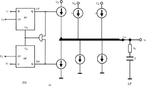amsdesign
Member level 3
Hello everyone,
This is how my circuit looks like

All the current sources are just current mirrors-each 20uA.
When I increase the number of source and sinks, the charging time becomes slower rather than getting faster.
For example. If I set 4 source and sinks. At time t, the output out is 1.02 volts.
If I decrease it to 4 source and sinks, for the same t, the output is now at 1.04 volts.
Can anyone tell me why this is happening? As I increase the current shouldn't the cap charge faster?
This is how my circuit looks like

All the current sources are just current mirrors-each 20uA.
When I increase the number of source and sinks, the charging time becomes slower rather than getting faster.
For example. If I set 4 source and sinks. At time t, the output out is 1.02 volts.
If I decrease it to 4 source and sinks, for the same t, the output is now at 1.04 volts.
Can anyone tell me why this is happening? As I increase the current shouldn't the cap charge faster?